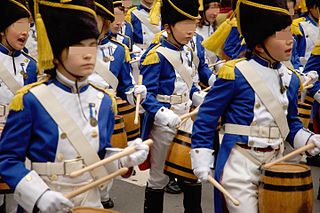San Sebastián Drum Festival
The Drum Festival of San Sebastián ( Spanish Tamborrada de San Sebastián, Basque Donostiako danborrada ) is the festival with which the city of Donostia-San Sebastián (in the province of Gipuzkoa in the Spanish Basque Country ) celebrates the day of Saint Sebastian on January 20th .
The drum festival
The festival begins at midnight on January 19th and 20th in Constitution Square with the raising of the city flag . The union Gaztelubide and representatives of other drum groups begin the march from San Sebastián the musician Raimundo Sarriegui to and other pieces drums . Around 100 companies, each consisting of 20 to 50 real drummers and 50 to 100 barrel drummers, march through all the districts of the city on January 20th .
Attendees
The participants in the more than 125 drum runs, which together pull more than 14,000 participants through the city, are divided into two groups: the drummers and the cooks and water carriers . The drummers wear a uniform from an army unit from the time of Napoleon . The latter play instruments with the same sound: the barrel and the milking bucket . Prasser , flag bearers and canteen hosts also take part .
In the morning the children hold the children's drumming (with 5000 participants), which starts in the gardens of Alderdi Eder and runs along the main arteries of the city. Among them the general and his aides and the beautiful Easo and her bridesmaids are chosen.
The festival lasts until midnight on January 21st, when the people gather again in Constitution Square around the drum group of the Unión Artesana . This company plays the Sarriegui compositions for the last time and closes at midnight with the March of San Sebastián, while the Mayor takes down the San Sebastián flag. After the flag has been raised, pieces different from those played during the day are interpreted, the March of the Cossacks of Kazan , the Anthem of the Real Sociedad San Sebastián and others.
During these 24 hours, the city's most important prizes are awarded, the Golden Drum and the Civil Order of Merit of San Sebastian.
March from San Sebastián
The text of the march was written by Serafín Baroja , the father of Pío Baroja , who was also a writer in San Sebastián. The following is sung, exclusively in Basque:
|
Current Basque version |
Translation |
However, thanks to a study carried out by the Municipality of San Sebastián in 2008, based on a publication in the local newspaper El Urumea on January 10, 1884, the original version, as compiled by Serafín Baroja, was found. The original text will likely be:
|
Original version |
Translation |
The march is divided into three parts: the first praises the city, unique in the world, and the saint, the only one of his name in heaven. The second part speaks of the Joxemaritas or Jose-Maris who move from street to street making music to entertain the people. In today's version, the first sentence that speaks of “joxemaritarras” alludes to the “young and old” and this is repeated in the same sentence. In the original version, however, the first sentence is identical to today's, but the following asks: “Josemari, mix with the women”.
The third part refers to the fact that after midnight you should forget your worries, as the drummers start screaming through the city and the carnival celebrations are approaching. In addition, at the beginning and at the end of the song it is said, “We are here too, always happy, always happy”.
Drum companies
There are just over 100 adult drumming societies that were originally reserved for men, but are now mostly open to women. There are also separate societies for children (for example belonging to a school or a boy scout ) and children's departments within the adult societies . Some of the city's sports clubs have a drum department, such as the Atlético San Sebastián football club , the Real Club de Tenis and the Bera Bera rugby club . The oldest society is the Gastronomic Society "Craftsmen Association" (Unión Artesana), which was founded in 1870, the youngest that of the "Choir School of the Virgin Mother" (Koruko Ama Birjinaren Eskola) , which was founded in 2012.
Each society is more or less firmly assigned to a certain city district. The drum runs of the various companies start at different times at their respective locations and follow a predetermined route through the streets of the area.
The children move through the city center with 52 societies from most of the city's school centers. In addition to this drum run, a single children's society runs through the El Antiguo district .
Web links
- Geografía e historia de San Sebastián, text about the drum festival of San Sebastián
- Geografía e historia de San Sebastián, video recording of one of the more than 125 drum runs
Individual evidence
- ↑ Archived copy ( memento of the original from October 29, 2010 in the Internet Archive ) Info: The archive link was inserted automatically and has not yet been checked. Please check the original and archive link according to the instructions and then remove this notice.

